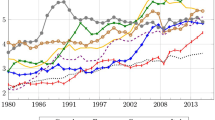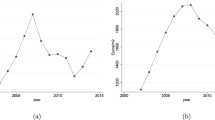Abstract
This study presents the results of an empirical analysis of the demand for money in the European Union as a whole over the period 1971–1995, with a particular focus on the impact of financial wealth. The empirical evidence shows a substantial impact of wealth on the demand for M2 and M3, whereas no influence of wealth on the demand for M1 is found. This finding may explain the remarkable increase of the broad monetary aggregates over the last decade or so. This means that taking into account the growth of wealth, the monetary expansion has been fairly modest. The evidence thus indicates that the strong increase of M2 and M3 should be attributed to portfolio investment considerations rather than to an expansionary monetary policy.
Similar content being viewed by others
References
Bekx P, Tullio G (1989) A note on the European Monetary System and the determination of the DM-dollar exchange rate. Cahiers économiques de Bruxelles 123:329–343
Boswijk HP (1994) Testing for an unstable root in conditional and structural error correction models. Journal of Econometrics 63:37–60
Brainard WC, Tobin J (1968) Pitfalls in financial model building. American Economic Review 58:99–122
Butter FAG, Fase MMG (1981) The demand for money in EEC countries. Journal of Monetary Economics 7:201–230
Deutsche Bundesbank (1995) Uberprüfung des Geldmengenziels und Neuordnung der Mindestreserve. Monatsberichte Juli 1995
Divisia F (1925, 1926) L'indice monétaire et la théorie de la monnaie. Revue d'Economie Politique 39:842–861, 980–1008, 1121–1151; and 40:49–87
Fase MMG (1994) In search for stability: an empirical appraisal of the demand for money in G7 and EC countries. De Economist 142:421–454
Fase MMG (1995) Divisia aggregates and the demand for money in core EMU. to appear In: Belongia MT (ed.) Theory and practice of Divisia monetary aggregates. St. Martin/MacMillan, New York/London
Fase MMG, Kuné JB (1974) De vraag naar liquiditeiten in Nederland −1952–1971. De Economist 122:326–356
Fase MMG, Winder CCA (1993) The demand for money in The Netherlands and other EC countries. De Economist 141:471–496
Fase MMG, Winder CCA (1994) Money demand within EMU — an analysis with the Divisia measure. De Nederlandsche Bank Quarterly Bulletin September 1994:25–55
Fase MMG, Winder CCA (1996) Wealth and the demand for money: Empirical evidence for The Netherlands and Belgium. De Economist 144:569–589
Fase MMG, Winder CCA (1997) Wealth and the demand for money in the European Union. BIS Conference Papers 4:340–362
Filosa R (1995) Money demand stability and currency substitution in six European countries (1980–1992). BIS Working Paper no. 30
Friedman M (1971) A theoretical framework for monetary analysis. National Bureau of Economic Research, Colombia University Press, New York
Gerdesmeier D (1996) Die Rolle des Vermögens in der Geldnachfrage. Deutsche Bundesbank Diskussionspapier 5/96
Hall SG, Henry SGB, Wilcox JB (1989) The long run determination of the UK monetary aggregates. Bank of England Discussion Papers nr 41
Inder B (1993) Estimating long-run relationships in economics — a comparison of different approaches, Journal of Econometrics. 57:53–68
Kremers JJM, Ericsson NR, Dolado JJ (1992) The power of cointegration tests. Oxford Bulletin of Economics and Statistics 54:325–348
Kremers JJM, Lane TD (1990) Economic and monetary integration and the aggregate demand for money in the EMS. IMF Staff Papers 37:777–805
Monticelli C, Strauss-Kahn M (1992) European integration and the demand for broad money. BIS Working Paper no. 18
Sterken E (1992) The financial transactions motive in the Dutch money demand equation. Kredit und Kapital 25:386–405
Winder CCA (1997) On the construction of European area-wide aggregates — a review of the issues and empirical evidence. Irving Fisher Committee on Central-Bank Statistics, IFC Bulletin 1:15–23
Author information
Authors and Affiliations
Additional information
Helpful comments by two anonymous referees, the participants in the Workshop on Money Demand at the Humboldt Universität and Hans Lunsing gratefully acknowledged.
Rights and permissions
About this article
Cite this article
Fase, M.M.G., Winder, C.C.A. Wealth and the demand for money in the European Union. Empirical Economics 23, 507–524 (1998). https://doi.org/10.1007/BF01294420
Issue Date:
DOI: https://doi.org/10.1007/BF01294420




